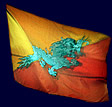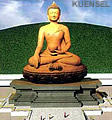|
Bhutan
to have the tallest statue of Lord Buddha |
 |
Bhutan
will have the largest and the tallest statue of Lord Buddha ever to be
built in the world. The 169-feet bronze statue of Buddha Dordenma, Vajra
Throne Buddha, symbolising indestructibility, and seated on a vajra
throne, will be erected at Kuensel Phodrang in Changbangdu, overlooking
the capital city.
Now
in ruins, Kuensel Phodrang was once the palace of the 13th Desi Sherab
Wangchuk. It is located some 100 metres above Thimphu on a slope. |
|
Approved
by His Majesty the King and the government, the Buddha Dordenma project
is being initiated by the chairman of Menjong Chhothuen Tshogpa, Lam Tshering
Wangdi, to commemorate the hundred years of monarchy in 2007.
In
order to fit the structure exactly on a one-acre land the foundation and
the concrete structures, which will support the statue, will be built as
soon as the government clears the five-kilometer approach road.
"The
government will also provide electricity and water supply," said Lam Tshering
Wangdi. "We are still waiting for the government to start the work."
|
The
Buddha statue will overlook the capital city
|
 |
 |
A model of the proposed statue
Within
the gigantic bronze structure including the thri (throne) there will be
enough space to house 17 storeys of different lhakhangs.
In
the first two storeys, which are both 15 feet high there will be 25,000
images of 12-inch Buddha Dordenma. "Made of copper and gilded in gold
they will be displayed around the walls of the meditation hall inside the
throne," Lam Tshering Wangdi said. "The names of the individual sponsors
of the statues will be engraved on copper-plate with powder coating." |
|
The first
storey, which surrounds the centre, will house eight 10-feet standing
bodhisattvas, the miracle sons of Buddha Shakyamuni.
The second
storey surrounding the centre pillar will have eight more 10-feet sitting Medicinal
Buddhas.
The third
storey inside the lotus seat will house six-feet high 16 arahats,
King Hashang (Maitreya Bodhisattva), Dharmata Tiger, Sutra Holder and the
four direction kings. In the centre chamber will be seated the main Buddha
Shakyamuni.
The
rooms from the third storey till the top will accommodate 100,000
statues of eight-inch Buddha Dordenma made of copper and gilded in
gold placed in multi-layered grid-boxes. "We will accept donations from
interested individuals for these eight-inch statues as well," said Lam
Tshering Wangdi. "The names of the donors will be inscribed separately
on copper-plates, and displayed in the meditation hall."
The
Bhutanese master sculptors had built a 12-meter high model statue of the
Buddha and given it to a Chinese company, Aerosun Corporation in Nanjing,
China. The work on the bronze statue began towards the end of 2004. To
make sure that the statue is given a Bhutanese look, the master sculptors
who made the model are frequently visiting China. The contract was given
to the Aerosun Corporation for US$ 20 million, which includes shipping
the 600-tonne statue to Bhutan after its completion in 2007 and assembling
it at Kuensel Phodrang.
Another 10
acres of land will be required to build public galleries, restaurants,
large parking spaces, camping grounds, dharamsalas and quarters for monks.
Lam
Tshering Wangdi said that before the contract was handed over to the Chinese
company, the proposal was taken to other Asian countries like India, Nepal,
Myanmar, Thailand and Indonesia. "But they all declined the offer stating
that it was too big a structure and would be impossible to complete it
within three years," said Lam Tshering.
Lam
Tshering later heard of a similar bronze statue of about 86 feet built
in Nanjing by the same Chinese company. The company was a major manufacturer
of bronze and copper, which are ideal and cheap material to build statues.
The company further reduced the cost of building the statue by US$ 5.0
million, according to Lam Tshering Wangdi.
The
statue is expected to be a major pilgrimage centre and a focal point
for Buddhists all over the world to converge, practice, meditate and retreat.
"It
is also meant to fulfill the prophecy of bestowing blessings, universal
peace and happiness to the world as a whole," Lam Tshering Wangdi said.
"I have taken this initiative in accordance with Lam Sonam Zangpo's prophecy,
a renowned yogi, who said that construction of a statue either of Guru,
Buddha or Phurba in this region would bring stability, peace and prosperity
in the country."
A
Singaporean billionaire, Rinchen Peter Teo, is the main sponsor of the
project.
This
article was contributed by Rinzin Wangchuk, KUENSEL, Bhutan's National
Newspaper |
 |
| Information on Bhutan |
 |
|



